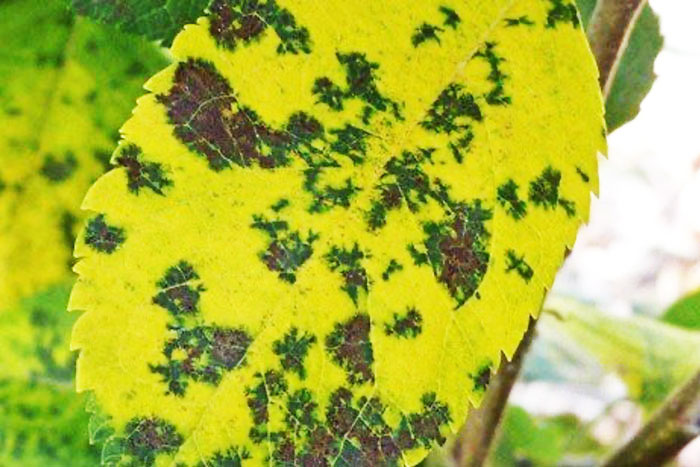Taking an environmentally sensitive approach to pest management
Marssonina Blotch on Apple Trees
Published: April 9, 2021
Marssonina coronaria is a fungal pathogen that causes apple leaf blotch symptoms, defoliation, and lesions on fruit. This disease has likely been in the United States since the early 1900's and is found in many apple-growing regions worldwide, especially in warm, wet summers. Although this disease is not caused by the same fungus as apple scab, it has been called "the scab of summer" in Asia.
Marssonina leaf spots first appear on the upper surface of mature leaves. The irregularly-shaped spots are grayish-brown with a purple border and are 1/8th to 3/8th inch-diameter. Tiny, black fruiting bodies, known as acervuli, are often found within the lesions. As lesions expand, much of the leaf becomes chlorotic and the defoliation occurs (Figure 1). Infection is favored by temperatures between 68 to 77°F and rainfall. Foliar symptoms begin to appear on mature leaves in mid to late June about eight days after infection. Defoliation may begin about two weeks after the leaf symptoms are apparent. On fruit, Marssonina first causes depressed brown lesions, which eventually turn black at harvest. However, fruit symptoms usually occur only when the leaves are severely infected with Marssonina.

Figure 1 Foliar chlorosis and lesions of Marssonina blotch disease on apple. (Photo credit: Kari Peter)
Apple cultivars differ in their susceptibility to Marssonina leaf blotch disease. Empire, Honeycrisp, and are very susceptible to this disease, whereas Cameo, Fuji, Gala, Red Delicious are less susceptible. Scab-resistant cultivars can become infected with Marssonina. Golden Delicious, Cortland, and Stayman are moderately resistant.
Marssonina leaf blotch can be managed by removing overwintered leaves on the ground, tree pruning for good air circulation and rapid foliar drying, and applying fungicides when needed. A spray program like that used for apple scab will also control Marssonina. Recommended fungicides for backyard apple trees are listed in Fruit Spray Schedules for the Homeowner at: https://extension.missouri.edu/publications/g6010?p=2 . During the summer, fungicides may be applied at a 14- to 21-day interval. However, when heavy rainfall occurs during that period, reapply a fungicide soon after the precipitation ends. For commercial growers, recommendations can be found in the Midwest Fruit Pest Management Guide at: https://ag.purdue.edu/hla/Hort/Documents/ID-465.pdf. Confirmation of leaf blotch can be obtained by submitting symptomatic leaves to the The MU Plant Diagnostic Clinic.
Subscribe to receive similar articles sent directly to your inbox!
- Scab-Resistant Apple Cultivars to Consider for Planting (04/04/22)
- Marssonina Blotch on Apple Trees (04/09/21)
- Getting to the Root of Burr Knots on Apple Trees (12/16/15)
REApril 9, 2021ate -->